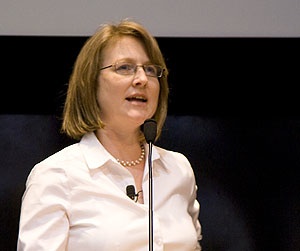 The American Wind Energy Association (AWEA) brought its “road show” to Iowa State’s Alliant Energy-Lee Liu Auditorium on Thursday, April 29, to challenge America’s leaders to adopt on a national scale the kinds of progressive energy policies that have made Iowa a literal powerhouse in wind and other renewable energy technologies.
The American Wind Energy Association (AWEA) brought its “road show” to Iowa State’s Alliant Energy-Lee Liu Auditorium on Thursday, April 29, to challenge America’s leaders to adopt on a national scale the kinds of progressive energy policies that have made Iowa a literal powerhouse in wind and other renewable energy technologies.
After opening remarks by College of Engineering Dean Jonathan Wickert, Joe Jongewaard of the Iowa Department of Economic Development, Iowa Wind Energy Association (IWEA) president Harold Prior, and Kathy Belyeu of the AWEA made presentations on the progress of wind energy development at both the state and national levels.
Jongewaard traced Iowa’s national leadership in wind energy to the state legislature’s visionary first-in-the-nation adoption of a renewable energy portfolio standard in 1983, as well as broad support for the standards across party lines and at all levels of government in Iowa. That, he said, has laid the groundwork for explosive growth in the next several years.
“We think we can take the necessary steps to create 10,000 jobs and a billion dollars in capital investments [in Iowa],” Jongewaard said. “We think that’s a fairly significant plan if we can accomplish it, and our deadline is the end of 2014.”
Because of its location and early momentum, Jongewaard said, Iowa has a small window of opportunity to expand manufacturing of turbines and other components before other states, Asia, and Mexico move to capture market share. The stakes are high, he added, with up to 8,000 turbines slated to be manufactured domestically each year in order to meet the U.S. Department of Energy’s goal of producing 20% of the nation’s electricity from wind by 2030.
Iowa, the panelists noted, sits at the center of a market in wind energy manufacturing within a 500-mile radius of Des Moines that was worth $7.8 billion in 2009 alone. Situated at the head of the nation’s “wind belt” to the west and load centers to the east, bordered by two rivers for barge traffic, and with major east-west and north-south interstate highways crossing the state, Iowa’s geographical and infrastructure advantages give it a leg up in competing for the industry’s future economic windfall.
The IWEA’s Prior noted that the economic benefits to the state of capturing these markets would be shared between urban equipment manufacturers and rural areas that would gain from site royalties paid to farmers and jobs servicing the turbines, not to mention general improvements to the state’s infrastructure. “This gives [Iowa] reasons to build more rail,” Prior said, “to improve our roadways so we can better haul these large units to the farms where they’re being constructed.”
However, Prior added, without enhanced transmission capacity and rigorous renewable portfolio standards on a national scale to assure a market for electricity from wind, manufacturers will be reticent to invest the significant sums needed to realize Iowa’s and the AWEA’s vision for 2030.
That call to lobby leaders for stronger national policies was repeated by the AWEA’s Kathy Belyeu, who used the organization’s 2009 annual report as a call to arms for the wind industry to press Congress and the White House to recapture markets for American equipment manufacturing.
“The opportunity is there,” Belyeu cautioned, “but the threat of losing the opportunity is there as well.” The United States, Belyeu observed, lost significant market share in equipment manufacturing to Europe in the 1980s because European leaders created a stable policy environment to support the wind industry. Today, she added, the United States is faced with having to win those markets back for domestic installation of wind energy.
“What we need when we talk about establishing a supply chain in the U.S. is long-term, stable signals so the manufacturers have the confidence to invest,” Belyeu said. “The thing that drives manufacturers to invest their money all down the supply chain is the stability of project development over a long period of time.
“Most developed countries have goals in place on a national level for renewables,” she continued. “The U.S. does not have any kind of national goals. Iowa does, and that has been a boon to development in Iowa. So one of the things we want to tell Congress is that you need to learn from Iowa.”